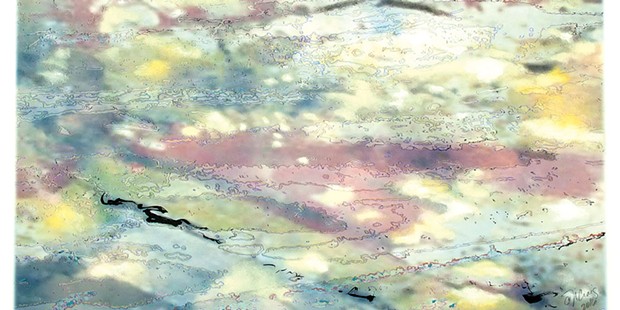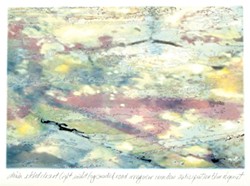[
{
"name": "Top Stories Video Pair",
"insertPoint": "7",
"component": "17087298",
"parentWrapperClass": "fdn-ads-inline-content-block",
"requiredCountToDisplay": "1"
}
]
It is possible to look right through the surfaces of Natalie Craig's mixed media paintings, admiring their airy architecture. They are multi-layered, like baklava or Jenga. Inside the laminate picture planes, each translucent leaf is differently inscribed. Pencil, oil, gouache and digital photo prints — each medium embodies different moments of the process. Craig said she wanted to make pictures that revealed the fantastic, nonlinear way the mind actually arranges information, instead of reproducing the more pedestrian way we reconstruct experience through narrative.
Piante Gallery hosts works by Craig and Marilyn Andrews in concurrent shows this month. While the shows have been conceived separately, there's a common thread: Both artists' works preserve an uncommon level of transparency with regard to process.
Craig's 16 paintings come from a series called stories. Each is accompanied by a hand-written, open-verse text running beneath the lower margin. The relationship between text and image ranges from illustrative to obscure. The pictures come in different sizes, from an expansive 30- by-40-inch format to a grouping of works just 8 inches square. They're all based on an ongoing series of experiments begun years ago when Craig started taking sunrise photographs.
"Where I live faces due east, and I'm an early riser. About four years ago, I decided to take a photograph of the sunrise each morning," Craig explained. She exhibited a series of paintings based on this project at the Morris Graves Museum last year. Those works yielded a reservoir of imagery that continues to inform the stories series. "I knew I was going to be drawing back into those images," she said.
Finding a support that could accommodate this process proved a challenge. Craig needed a material that would yield high-quality imagery with an inkjet printer, yet was also substantial enough for intensive annotation in pencil, gouache and oil. A heavy grade of rag and bamboo paper passed both tests.
Craig says she's interested in the subjectivity of experience: the way "10 of us might read the same book, and each will get something very different out of it." She works exclusively from self-generated materials, including photographs she has taken and sketches she has drawn from life. She does much of her editing in Photoshop. "I'll look at the photographs and identify areas that are especially interesting, cropping areas out, or blowing them up."
In "light road window," an intricate, digitally printed line drawing derived from a photo overlaps a skein of glowing colors that recall dappled sunlight under trees. Craig clearly decided to allow only certain elements of her digital source material to remain opaque; other areas have gone translucent or dropped out altogether. Once superimposed, these layers become more than the sum of their parts.
"The underlying concept dances in and out," Craig said, "how we can be one place in the moment, and yet at the same time be somewhere a thousand miles away as well. When we start daydreaming, the experience of the present moment gets layered and colored with memories of the past in unpredictable ways." Craig's paintings don't just illustrate this process; they enact it.
Marilyn Andrews' sculptures and wall reliefs don't have literal layers, but their assemblage bespeaks a different kind of step-by-step process. Every component of these assemblages proceeds from its adjacent parts as though it were their logical synthesis.
Andrews' show, Working on a String of Impulses, takes its title from a sentence in M Train, Patti Smith's recently published second volume of memoir. It's easy to believe that the experience of creating these artworks felt that way, with each decision emerging organically from the ones that came before. The formal relationships that sustain this work are often eye opening, but nothing ever looks less than necessary. Andrews is a calligrapher as well as a sculptor, and it shows: Her works possess a refined economy of form that recalls the best fonts.
A group of Andrews' vertically oriented bronzes is built around a sequence of articulated forms that evoke both natural and industrial processes. Solid bases give rise to sinewy, shapes that recall spoons, levers, wedges and stick shifts. Some forms are smooth, others heavily textured; still others are embossed with a wavy pattern that might evoke stylized ocean waves until you realize how forcibly it recalls the corrugated surfaces of some cast-iron cooking implements.
Most of these sculptures have recognizably human scale, and they resemble switches, control panels and gameboards. It's easy to imagine taking hold of the smooth bronze levers, disrupting the placid equilibrium of the tapering forms. It may be an effort not to touch.
Andrews' assemblage process comes across both opportunistic and visionary. She's comfortable deriving inspiration from wherever. And (much like Smith), she's alive to the poetic possibilities of everyday objects. Her sculptures splice structures from the factory, the kitchen and the orchard together with passages that recall the human form.
Andrews said she often waits long periods before serendipity or intuition reveal the form that will complete a sculpture. That's easy to appreciate when you regard the work. Wandlike switches cut from Andrews' apple trees interface with irregular industrial fragments from the Arcata scrapyard. Painted plywood moldings straight out of 1970s office décor support rusted switchplates and open-faced fiberglass compartments. Andrews' husband is a surveyor, and the levels, tripods and brass bobs of his trade appear regularly.
In Andrews' pieces, machine forms are just as important as those from the natural world. The work seems simultaneously de-natured and post-industrial — acutely contemporary, like many of the landscapes that surround us.
There will be an opening reception for the artists during Arts Alive! on Saturday, April 2 from 6 p.m.
more from the author
-
Nancy Tobin's CRy-Baby Installation at CR
- Feb 22, 2024
-
Truth Units
Bachrun LoMele's Burn Pile/The Andromeda Mirage at the Morris Graves
- Sep 7, 2023
-
Ruth Arietta's Illusory Interiors at Morris Graves Museum of Art
- Aug 10, 2023
- More »

































